Organisational Behaviour and Human Resource Issues: Final Report
VerifiedAdded on 2022/09/03
|26
|7290
|21
Report
AI Summary
This report addresses key topics in organisational behaviour and human resource issues, focusing on diversity, mergers, and strategic HR management. It begins by exploring the four layers of diversity—personality, internal dimensions, external dimensions, and organisational dimensions—and how awareness of these layers can help organisations manage diversity effectively. The report then examines the social and political significance of a diverse workforce, with specific examples from Malaysia, including single parents, women in business, ethnicity, older workers, people with disabilities, immigrants, and foreign workers. Finally, the report discusses the role of strategic human resource management in helping organisations navigate the transitional periods of mergers and acquisitions, highlighting the importance of HR involvement in planning, integration, and due diligence. The report provides a comprehensive overview of these critical areas, offering valuable insights for understanding and managing the complexities of organisational behaviour and human resources.
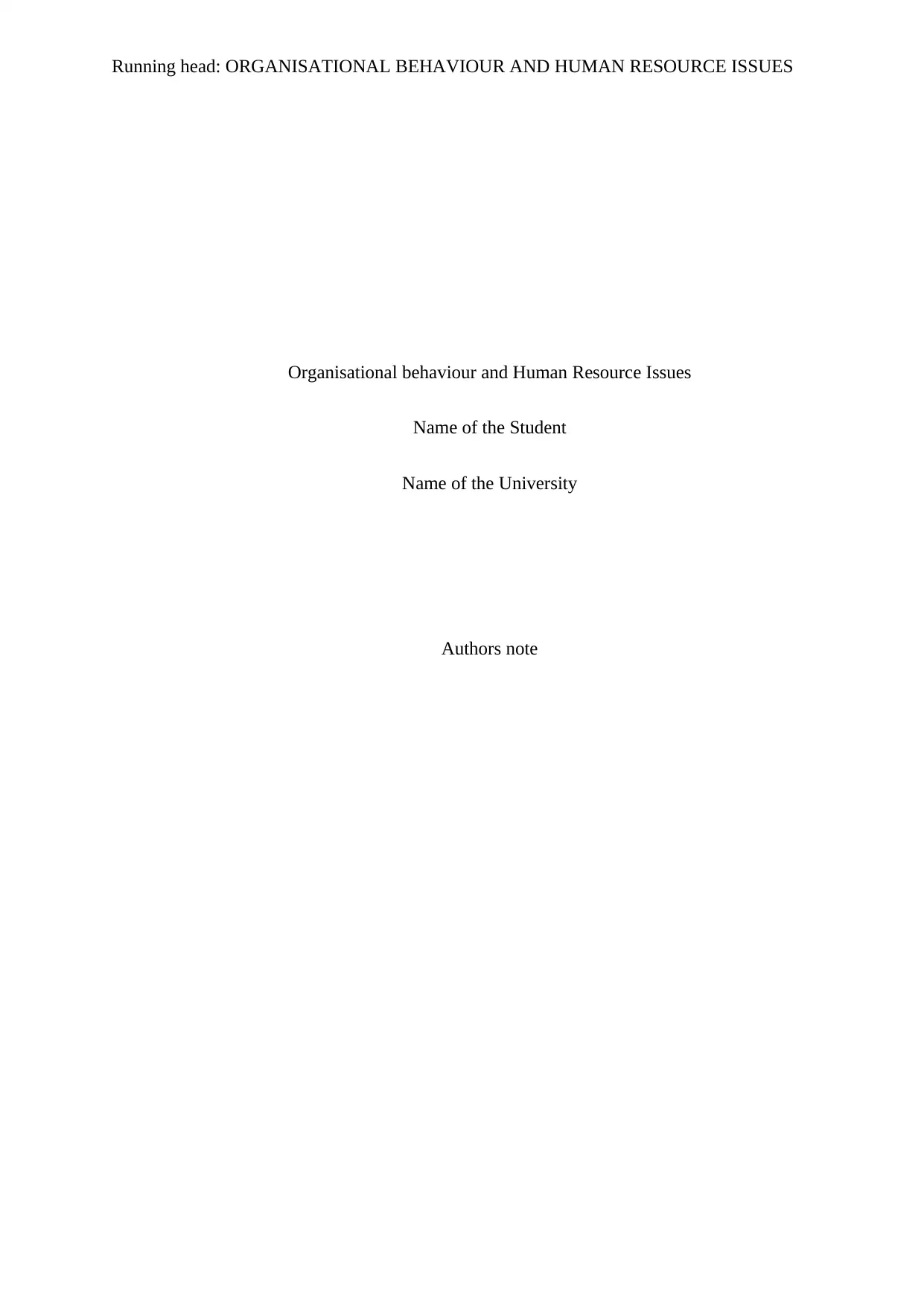
Running head: ORGANISATIONAL BEHAVIOUR AND HUMAN RESOURCE ISSUES
Organisational behaviour and Human Resource Issues
Name of the Student
Name of the University
Authors note
Organisational behaviour and Human Resource Issues
Name of the Student
Name of the University
Authors note
Paraphrase This Document
Need a fresh take? Get an instant paraphrase of this document with our AI Paraphraser
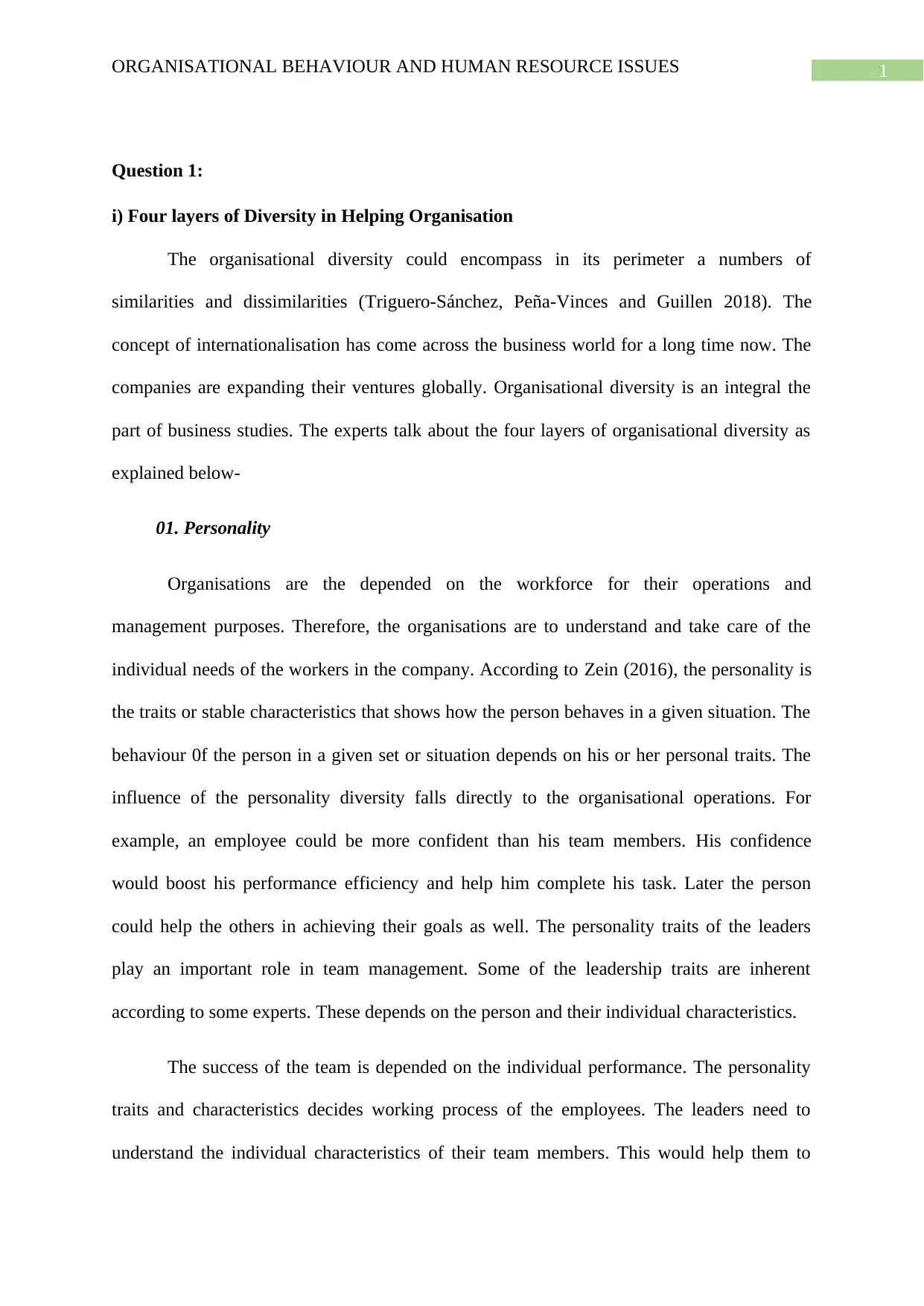
1ORGANISATIONAL BEHAVIOUR AND HUMAN RESOURCE ISSUES
Question 1:
i) Four layers of Diversity in Helping Organisation
The organisational diversity could encompass in its perimeter a numbers of
similarities and dissimilarities (Triguero-Sánchez, Peña-Vinces and Guillen 2018). The
concept of internationalisation has come across the business world for a long time now. The
companies are expanding their ventures globally. Organisational diversity is an integral the
part of business studies. The experts talk about the four layers of organisational diversity as
explained below-
01. Personality
Organisations are the depended on the workforce for their operations and
management purposes. Therefore, the organisations are to understand and take care of the
individual needs of the workers in the company. According to Zein (2016), the personality is
the traits or stable characteristics that shows how the person behaves in a given situation. The
behaviour 0f the person in a given set or situation depends on his or her personal traits. The
influence of the personality diversity falls directly to the organisational operations. For
example, an employee could be more confident than his team members. His confidence
would boost his performance efficiency and help him complete his task. Later the person
could help the others in achieving their goals as well. The personality traits of the leaders
play an important role in team management. Some of the leadership traits are inherent
according to some experts. These depends on the person and their individual characteristics.
The success of the team is depended on the individual performance. The personality
traits and characteristics decides working process of the employees. The leaders need to
understand the individual characteristics of their team members. This would help them to
Question 1:
i) Four layers of Diversity in Helping Organisation
The organisational diversity could encompass in its perimeter a numbers of
similarities and dissimilarities (Triguero-Sánchez, Peña-Vinces and Guillen 2018). The
concept of internationalisation has come across the business world for a long time now. The
companies are expanding their ventures globally. Organisational diversity is an integral the
part of business studies. The experts talk about the four layers of organisational diversity as
explained below-
01. Personality
Organisations are the depended on the workforce for their operations and
management purposes. Therefore, the organisations are to understand and take care of the
individual needs of the workers in the company. According to Zein (2016), the personality is
the traits or stable characteristics that shows how the person behaves in a given situation. The
behaviour 0f the person in a given set or situation depends on his or her personal traits. The
influence of the personality diversity falls directly to the organisational operations. For
example, an employee could be more confident than his team members. His confidence
would boost his performance efficiency and help him complete his task. Later the person
could help the others in achieving their goals as well. The personality traits of the leaders
play an important role in team management. Some of the leadership traits are inherent
according to some experts. These depends on the person and their individual characteristics.
The success of the team is depended on the individual performance. The personality
traits and characteristics decides working process of the employees. The leaders need to
understand the individual characteristics of their team members. This would help them to
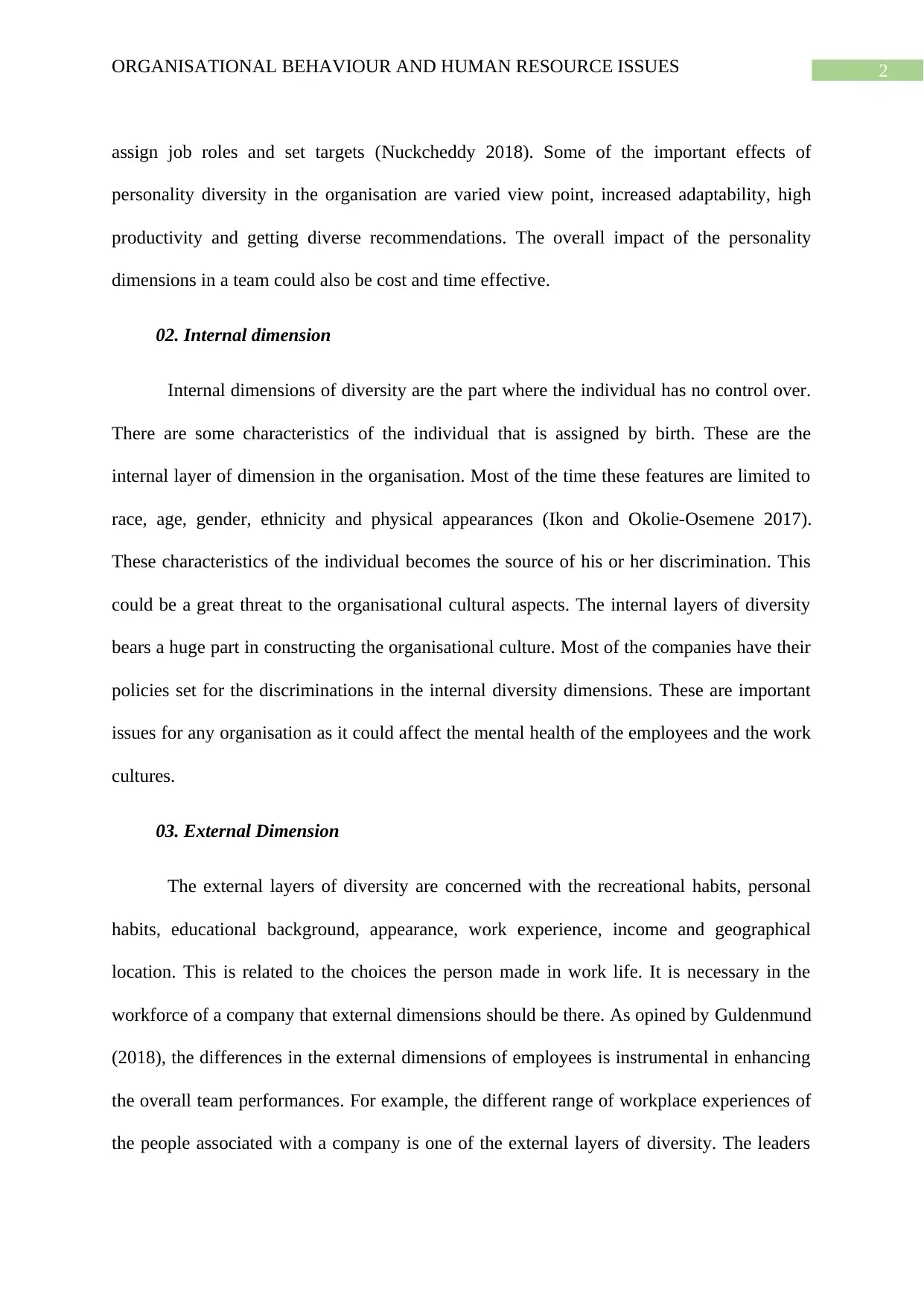
2ORGANISATIONAL BEHAVIOUR AND HUMAN RESOURCE ISSUES
assign job roles and set targets (Nuckcheddy 2018). Some of the important effects of
personality diversity in the organisation are varied view point, increased adaptability, high
productivity and getting diverse recommendations. The overall impact of the personality
dimensions in a team could also be cost and time effective.
02. Internal dimension
Internal dimensions of diversity are the part where the individual has no control over.
There are some characteristics of the individual that is assigned by birth. These are the
internal layer of dimension in the organisation. Most of the time these features are limited to
race, age, gender, ethnicity and physical appearances (Ikon and Okolie-Osemene 2017).
These characteristics of the individual becomes the source of his or her discrimination. This
could be a great threat to the organisational cultural aspects. The internal layers of diversity
bears a huge part in constructing the organisational culture. Most of the companies have their
policies set for the discriminations in the internal diversity dimensions. These are important
issues for any organisation as it could affect the mental health of the employees and the work
cultures.
03. External Dimension
The external layers of diversity are concerned with the recreational habits, personal
habits, educational background, appearance, work experience, income and geographical
location. This is related to the choices the person made in work life. It is necessary in the
workforce of a company that external dimensions should be there. As opined by Guldenmund
(2018), the differences in the external dimensions of employees is instrumental in enhancing
the overall team performances. For example, the different range of workplace experiences of
the people associated with a company is one of the external layers of diversity. The leaders
assign job roles and set targets (Nuckcheddy 2018). Some of the important effects of
personality diversity in the organisation are varied view point, increased adaptability, high
productivity and getting diverse recommendations. The overall impact of the personality
dimensions in a team could also be cost and time effective.
02. Internal dimension
Internal dimensions of diversity are the part where the individual has no control over.
There are some characteristics of the individual that is assigned by birth. These are the
internal layer of dimension in the organisation. Most of the time these features are limited to
race, age, gender, ethnicity and physical appearances (Ikon and Okolie-Osemene 2017).
These characteristics of the individual becomes the source of his or her discrimination. This
could be a great threat to the organisational cultural aspects. The internal layers of diversity
bears a huge part in constructing the organisational culture. Most of the companies have their
policies set for the discriminations in the internal diversity dimensions. These are important
issues for any organisation as it could affect the mental health of the employees and the work
cultures.
03. External Dimension
The external layers of diversity are concerned with the recreational habits, personal
habits, educational background, appearance, work experience, income and geographical
location. This is related to the choices the person made in work life. It is necessary in the
workforce of a company that external dimensions should be there. As opined by Guldenmund
(2018), the differences in the external dimensions of employees is instrumental in enhancing
the overall team performances. For example, the different range of workplace experiences of
the people associated with a company is one of the external layers of diversity. The leaders
⊘ This is a preview!⊘
Do you want full access?
Subscribe today to unlock all pages.

Trusted by 1+ million students worldwide

3ORGANISATIONAL BEHAVIOUR AND HUMAN RESOURCE ISSUES
could understand the efficiency and performance level of a specific employee according to
their experience. The job roles could be assigned according to that. There are projects in the
company which need less or more experienced people in different levels. This external
diversity in an organisation gives the freedom to the leaders to choose from a number of
employees the right person according to their work skills and experiences (Scott et al. 2018).
Again, the diversity in the geographical location provides the company with the scope of
innovation and creativity. The company could always try to increase their creativity level by
implying different strategies in different locations and achieve success. The parameters of
organisational profits are decided by the degree of diversity the company has in its resources.
Diverse workforce allows the company to experiment with new things and achieve targets
easily.
04. Organisational Dimension
The institutional or corporate affiliations of the organisations are related to the
organisational dimension of diversity. The important part of the organisational diversities are
the management status, divisional departments, work locations, union affiliations, seniority,
work field and classifications of the functional levels. The layer of organisational diversity is
controlled by the authority and the employees have minimum influence in these dimensions.
The organisational layer of diversity controls the environment in which the employees work.
Therefore, the importance of this dimension is immense in the performances as well. It is the
primary necessity of the organisation that it should manage the diversities in a way that
provides support to the people related to it. The interests and influence of the stakeholders are
the part of this diversity layers. According to Farndale et al. (2015), organisational
differences in diversity are instrumental in helping the employees to understand the
operational objectives and get workplace supports.
could understand the efficiency and performance level of a specific employee according to
their experience. The job roles could be assigned according to that. There are projects in the
company which need less or more experienced people in different levels. This external
diversity in an organisation gives the freedom to the leaders to choose from a number of
employees the right person according to their work skills and experiences (Scott et al. 2018).
Again, the diversity in the geographical location provides the company with the scope of
innovation and creativity. The company could always try to increase their creativity level by
implying different strategies in different locations and achieve success. The parameters of
organisational profits are decided by the degree of diversity the company has in its resources.
Diverse workforce allows the company to experiment with new things and achieve targets
easily.
04. Organisational Dimension
The institutional or corporate affiliations of the organisations are related to the
organisational dimension of diversity. The important part of the organisational diversities are
the management status, divisional departments, work locations, union affiliations, seniority,
work field and classifications of the functional levels. The layer of organisational diversity is
controlled by the authority and the employees have minimum influence in these dimensions.
The organisational layer of diversity controls the environment in which the employees work.
Therefore, the importance of this dimension is immense in the performances as well. It is the
primary necessity of the organisation that it should manage the diversities in a way that
provides support to the people related to it. The interests and influence of the stakeholders are
the part of this diversity layers. According to Farndale et al. (2015), organisational
differences in diversity are instrumental in helping the employees to understand the
operational objectives and get workplace supports.
Paraphrase This Document
Need a fresh take? Get an instant paraphrase of this document with our AI Paraphraser

4ORGANISATIONAL BEHAVIOUR AND HUMAN RESOURCE ISSUES
ii) Social and Political Significance of Diverse Workforce
(Ramos et al. 2016) (Knights and Omanović 2016) (Dwyer and Azevedo 2016)
(Roberson 2019) (Kundu and Mor 2017) (Kirton and Greene 2015) (Pringle and Ryan 2015)
(Gotsis and Grimani 2016) (Barak 2016) (Trittin and Schoeneborn 2017)
The diverse workforce has its own political and social significance. Managing the
diversity in an organisation is a task of bog challenge. The organisational managers have to
understand the different implications of their company employee diversity to manage them
properly. In order to implement the diversity management techniques and get the positive
outcomes from it, the significance of diverse people in the workplace needed to be assessed.
01. Single Parents and Working Mothers
The single parents and the working mothers have to face extra challenges regarding
managing their time and focus as they have to take care of the child. The organisations might
try to arrange supports for these people. The single parents and the working mother are
stronger than the other employees when it comes to their mental strength. Therefore, the
company authorities could help them to have an inclusive work environment and increasing
the social responsibility ethics of the company. Flexible work time and internal supports for
these people could help the company culture to flourish.
02. Women in Business
The number of women in the business leadership and all other parts are increasing
immensely. Unlike the past times, companies are giving to increase their female employee
number. There are evidences that the women employees or business owners could also
perform similar to the other people in the organisation. The women empowerment in the
ii) Social and Political Significance of Diverse Workforce
(Ramos et al. 2016) (Knights and Omanović 2016) (Dwyer and Azevedo 2016)
(Roberson 2019) (Kundu and Mor 2017) (Kirton and Greene 2015) (Pringle and Ryan 2015)
(Gotsis and Grimani 2016) (Barak 2016) (Trittin and Schoeneborn 2017)
The diverse workforce has its own political and social significance. Managing the
diversity in an organisation is a task of bog challenge. The organisational managers have to
understand the different implications of their company employee diversity to manage them
properly. In order to implement the diversity management techniques and get the positive
outcomes from it, the significance of diverse people in the workplace needed to be assessed.
01. Single Parents and Working Mothers
The single parents and the working mothers have to face extra challenges regarding
managing their time and focus as they have to take care of the child. The organisations might
try to arrange supports for these people. The single parents and the working mother are
stronger than the other employees when it comes to their mental strength. Therefore, the
company authorities could help them to have an inclusive work environment and increasing
the social responsibility ethics of the company. Flexible work time and internal supports for
these people could help the company culture to flourish.
02. Women in Business
The number of women in the business leadership and all other parts are increasing
immensely. Unlike the past times, companies are giving to increase their female employee
number. There are evidences that the women employees or business owners could also
perform similar to the other people in the organisation. The women empowerment in the
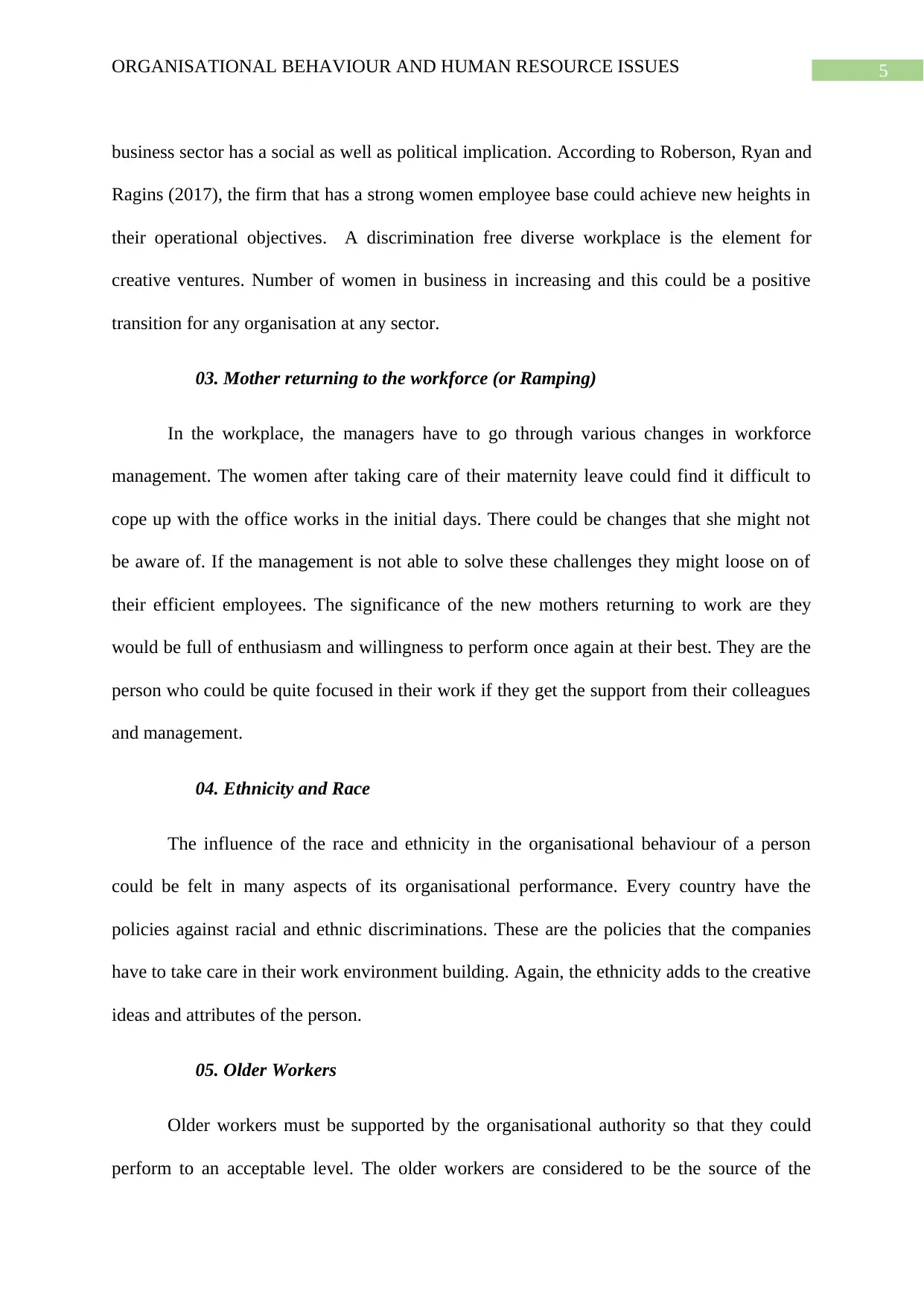
5ORGANISATIONAL BEHAVIOUR AND HUMAN RESOURCE ISSUES
business sector has a social as well as political implication. According to Roberson, Ryan and
Ragins (2017), the firm that has a strong women employee base could achieve new heights in
their operational objectives. A discrimination free diverse workplace is the element for
creative ventures. Number of women in business in increasing and this could be a positive
transition for any organisation at any sector.
03. Mother returning to the workforce (or Ramping)
In the workplace, the managers have to go through various changes in workforce
management. The women after taking care of their maternity leave could find it difficult to
cope up with the office works in the initial days. There could be changes that she might not
be aware of. If the management is not able to solve these challenges they might loose on of
their efficient employees. The significance of the new mothers returning to work are they
would be full of enthusiasm and willingness to perform once again at their best. They are the
person who could be quite focused in their work if they get the support from their colleagues
and management.
04. Ethnicity and Race
The influence of the race and ethnicity in the organisational behaviour of a person
could be felt in many aspects of its organisational performance. Every country have the
policies against racial and ethnic discriminations. These are the policies that the companies
have to take care in their work environment building. Again, the ethnicity adds to the creative
ideas and attributes of the person.
05. Older Workers
Older workers must be supported by the organisational authority so that they could
perform to an acceptable level. The older workers are considered to be the source of the
business sector has a social as well as political implication. According to Roberson, Ryan and
Ragins (2017), the firm that has a strong women employee base could achieve new heights in
their operational objectives. A discrimination free diverse workplace is the element for
creative ventures. Number of women in business in increasing and this could be a positive
transition for any organisation at any sector.
03. Mother returning to the workforce (or Ramping)
In the workplace, the managers have to go through various changes in workforce
management. The women after taking care of their maternity leave could find it difficult to
cope up with the office works in the initial days. There could be changes that she might not
be aware of. If the management is not able to solve these challenges they might loose on of
their efficient employees. The significance of the new mothers returning to work are they
would be full of enthusiasm and willingness to perform once again at their best. They are the
person who could be quite focused in their work if they get the support from their colleagues
and management.
04. Ethnicity and Race
The influence of the race and ethnicity in the organisational behaviour of a person
could be felt in many aspects of its organisational performance. Every country have the
policies against racial and ethnic discriminations. These are the policies that the companies
have to take care in their work environment building. Again, the ethnicity adds to the creative
ideas and attributes of the person.
05. Older Workers
Older workers must be supported by the organisational authority so that they could
perform to an acceptable level. The older workers are considered to be the source of the
⊘ This is a preview!⊘
Do you want full access?
Subscribe today to unlock all pages.

Trusted by 1+ million students worldwide
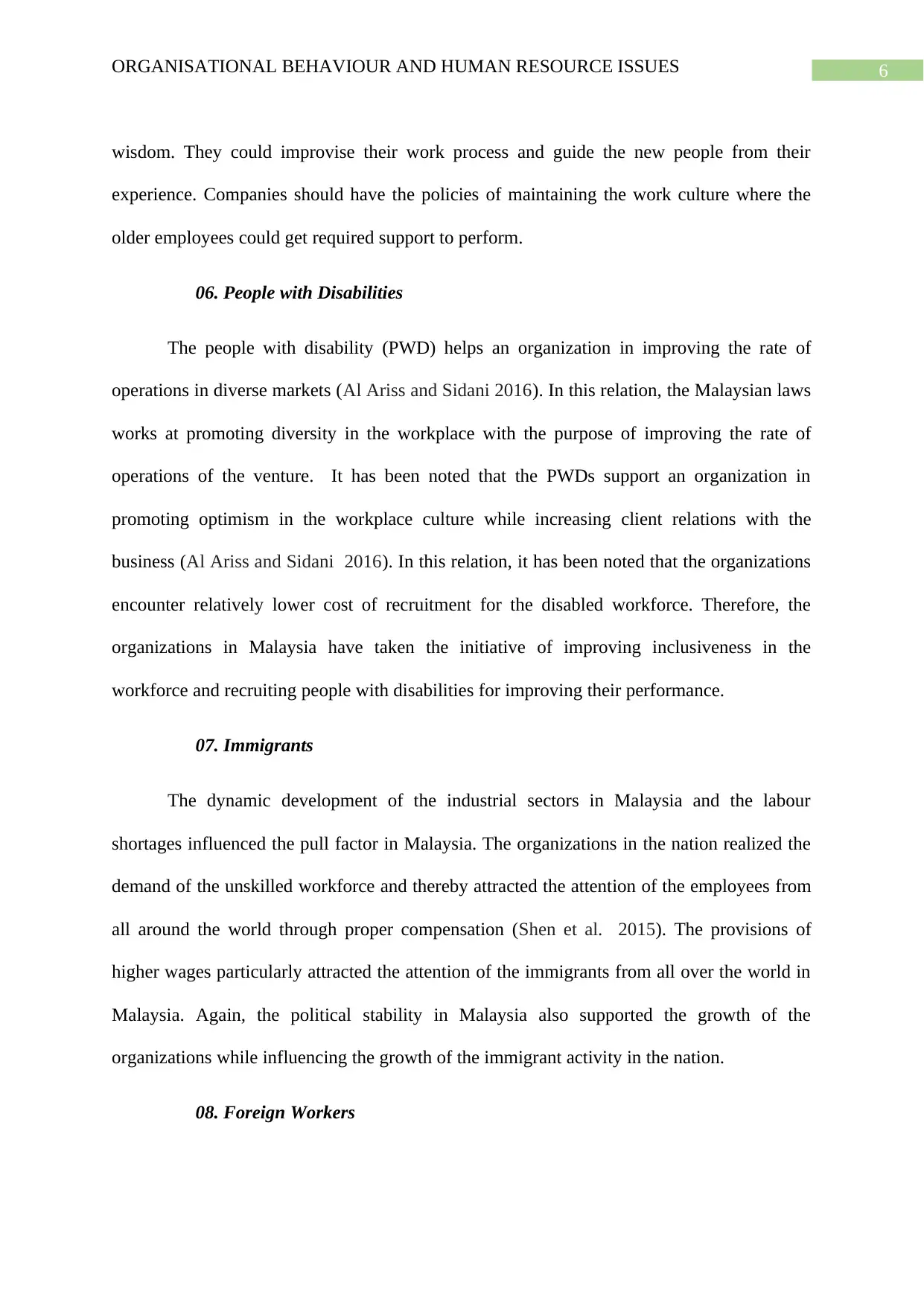
6ORGANISATIONAL BEHAVIOUR AND HUMAN RESOURCE ISSUES
wisdom. They could improvise their work process and guide the new people from their
experience. Companies should have the policies of maintaining the work culture where the
older employees could get required support to perform.
06. People with Disabilities
The people with disability (PWD) helps an organization in improving the rate of
operations in diverse markets (Al Ariss and Sidani 2016). In this relation, the Malaysian laws
works at promoting diversity in the workplace with the purpose of improving the rate of
operations of the venture. It has been noted that the PWDs support an organization in
promoting optimism in the workplace culture while increasing client relations with the
business (Al Ariss and Sidani 2016). In this relation, it has been noted that the organizations
encounter relatively lower cost of recruitment for the disabled workforce. Therefore, the
organizations in Malaysia have taken the initiative of improving inclusiveness in the
workforce and recruiting people with disabilities for improving their performance.
07. Immigrants
The dynamic development of the industrial sectors in Malaysia and the labour
shortages influenced the pull factor in Malaysia. The organizations in the nation realized the
demand of the unskilled workforce and thereby attracted the attention of the employees from
all around the world through proper compensation (Shen et al. 2015). The provisions of
higher wages particularly attracted the attention of the immigrants from all over the world in
Malaysia. Again, the political stability in Malaysia also supported the growth of the
organizations while influencing the growth of the immigrant activity in the nation.
08. Foreign Workers
wisdom. They could improvise their work process and guide the new people from their
experience. Companies should have the policies of maintaining the work culture where the
older employees could get required support to perform.
06. People with Disabilities
The people with disability (PWD) helps an organization in improving the rate of
operations in diverse markets (Al Ariss and Sidani 2016). In this relation, the Malaysian laws
works at promoting diversity in the workplace with the purpose of improving the rate of
operations of the venture. It has been noted that the PWDs support an organization in
promoting optimism in the workplace culture while increasing client relations with the
business (Al Ariss and Sidani 2016). In this relation, it has been noted that the organizations
encounter relatively lower cost of recruitment for the disabled workforce. Therefore, the
organizations in Malaysia have taken the initiative of improving inclusiveness in the
workforce and recruiting people with disabilities for improving their performance.
07. Immigrants
The dynamic development of the industrial sectors in Malaysia and the labour
shortages influenced the pull factor in Malaysia. The organizations in the nation realized the
demand of the unskilled workforce and thereby attracted the attention of the employees from
all around the world through proper compensation (Shen et al. 2015). The provisions of
higher wages particularly attracted the attention of the immigrants from all over the world in
Malaysia. Again, the political stability in Malaysia also supported the growth of the
organizations while influencing the growth of the immigrant activity in the nation.
08. Foreign Workers
Paraphrase This Document
Need a fresh take? Get an instant paraphrase of this document with our AI Paraphraser

7ORGANISATIONAL BEHAVIOUR AND HUMAN RESOURCE ISSUES
The foreign workers and the expatriates from the different outbound organizations are
attracted towards the Malaysian workforce due to the higher rate of wages and the leniency of
the organizational governance. The Malaysian organizations attract the attention of the skilled
employees and managers with practical experience while offering the same with different
amenities (Collings, Wood and Szamosi 2018). The ease of doing work in the Malaysian
organizational context supported diversity in the workforce while operating in the different
markets. The key changes in the organizational operations are based on the efficient
functioning of the different systems in accordance to the demand of the customers.
09. Young Persons, Some with Limited Education or Skills
The young persons with limited education and skills are mostly required in the
Malaysian Manufacturing and production based organizations. The organizations take the
initiative of attracting the attention of the customers while operating in the different markets.
The young and enthusiastic employees would empower the rate of performance of the
venture while operating on the production based objectives of the same (Stone and Deadrick
2015). Therefore, most of the Malaysian firms take the initiative of improving their
production through the inclusion of young employees with limited knowledge or skills on the
processes. The organizations provide the semi- skilled or unskilled employees with proficient
training on the organizational operations while encouraging their productions.
10. Baby Boomers, Gen X, Gen Y, and Gen Z
The inclusion of diverse range of employees from different age groups would
empower the rate of operations of the venture. It has been noted that the inclusion of older
employees strengthens the strategic discourse of the organization based on their practical
knowledge. On the other hand, the inclusion of younger and enthusiastic workforce
The foreign workers and the expatriates from the different outbound organizations are
attracted towards the Malaysian workforce due to the higher rate of wages and the leniency of
the organizational governance. The Malaysian organizations attract the attention of the skilled
employees and managers with practical experience while offering the same with different
amenities (Collings, Wood and Szamosi 2018). The ease of doing work in the Malaysian
organizational context supported diversity in the workforce while operating in the different
markets. The key changes in the organizational operations are based on the efficient
functioning of the different systems in accordance to the demand of the customers.
09. Young Persons, Some with Limited Education or Skills
The young persons with limited education and skills are mostly required in the
Malaysian Manufacturing and production based organizations. The organizations take the
initiative of attracting the attention of the customers while operating in the different markets.
The young and enthusiastic employees would empower the rate of performance of the
venture while operating on the production based objectives of the same (Stone and Deadrick
2015). Therefore, most of the Malaysian firms take the initiative of improving their
production through the inclusion of young employees with limited knowledge or skills on the
processes. The organizations provide the semi- skilled or unskilled employees with proficient
training on the organizational operations while encouraging their productions.
10. Baby Boomers, Gen X, Gen Y, and Gen Z
The inclusion of diverse range of employees from different age groups would
empower the rate of operations of the venture. It has been noted that the inclusion of older
employees strengthens the strategic discourse of the organization based on their practical
knowledge. On the other hand, the inclusion of younger and enthusiastic workforce
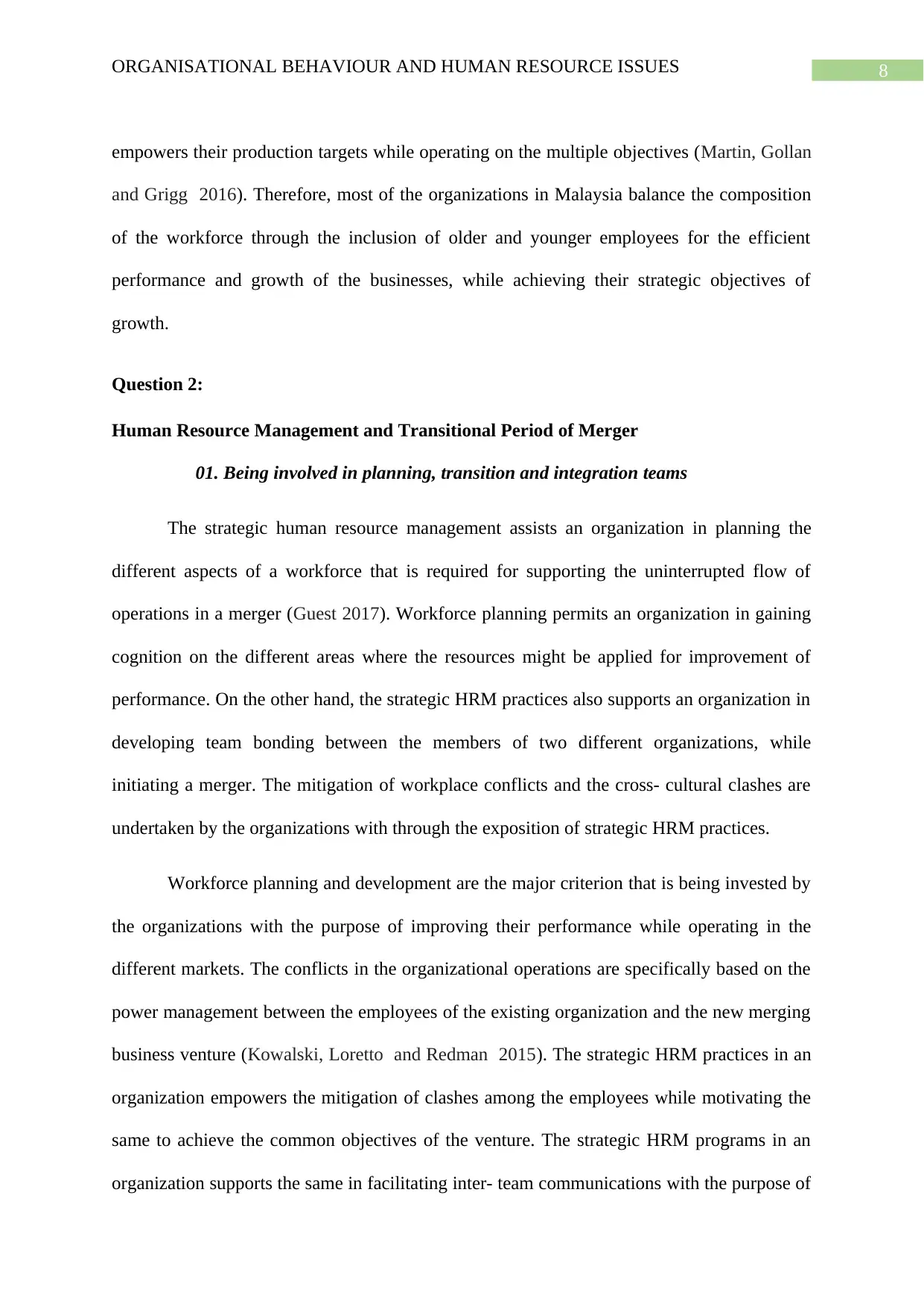
8ORGANISATIONAL BEHAVIOUR AND HUMAN RESOURCE ISSUES
empowers their production targets while operating on the multiple objectives (Martin, Gollan
and Grigg 2016). Therefore, most of the organizations in Malaysia balance the composition
of the workforce through the inclusion of older and younger employees for the efficient
performance and growth of the businesses, while achieving their strategic objectives of
growth.
Question 2:
Human Resource Management and Transitional Period of Merger
01. Being involved in planning, transition and integration teams
The strategic human resource management assists an organization in planning the
different aspects of a workforce that is required for supporting the uninterrupted flow of
operations in a merger (Guest 2017). Workforce planning permits an organization in gaining
cognition on the different areas where the resources might be applied for improvement of
performance. On the other hand, the strategic HRM practices also supports an organization in
developing team bonding between the members of two different organizations, while
initiating a merger. The mitigation of workplace conflicts and the cross- cultural clashes are
undertaken by the organizations with through the exposition of strategic HRM practices.
Workforce planning and development are the major criterion that is being invested by
the organizations with the purpose of improving their performance while operating in the
different markets. The conflicts in the organizational operations are specifically based on the
power management between the employees of the existing organization and the new merging
business venture (Kowalski, Loretto and Redman 2015). The strategic HRM practices in an
organization empowers the mitigation of clashes among the employees while motivating the
same to achieve the common objectives of the venture. The strategic HRM programs in an
organization supports the same in facilitating inter- team communications with the purpose of
empowers their production targets while operating on the multiple objectives (Martin, Gollan
and Grigg 2016). Therefore, most of the organizations in Malaysia balance the composition
of the workforce through the inclusion of older and younger employees for the efficient
performance and growth of the businesses, while achieving their strategic objectives of
growth.
Question 2:
Human Resource Management and Transitional Period of Merger
01. Being involved in planning, transition and integration teams
The strategic human resource management assists an organization in planning the
different aspects of a workforce that is required for supporting the uninterrupted flow of
operations in a merger (Guest 2017). Workforce planning permits an organization in gaining
cognition on the different areas where the resources might be applied for improvement of
performance. On the other hand, the strategic HRM practices also supports an organization in
developing team bonding between the members of two different organizations, while
initiating a merger. The mitigation of workplace conflicts and the cross- cultural clashes are
undertaken by the organizations with through the exposition of strategic HRM practices.
Workforce planning and development are the major criterion that is being invested by
the organizations with the purpose of improving their performance while operating in the
different markets. The conflicts in the organizational operations are specifically based on the
power management between the employees of the existing organization and the new merging
business venture (Kowalski, Loretto and Redman 2015). The strategic HRM practices in an
organization empowers the mitigation of clashes among the employees while motivating the
same to achieve the common objectives of the venture. The strategic HRM programs in an
organization supports the same in facilitating inter- team communications with the purpose of
⊘ This is a preview!⊘
Do you want full access?
Subscribe today to unlock all pages.

Trusted by 1+ million students worldwide
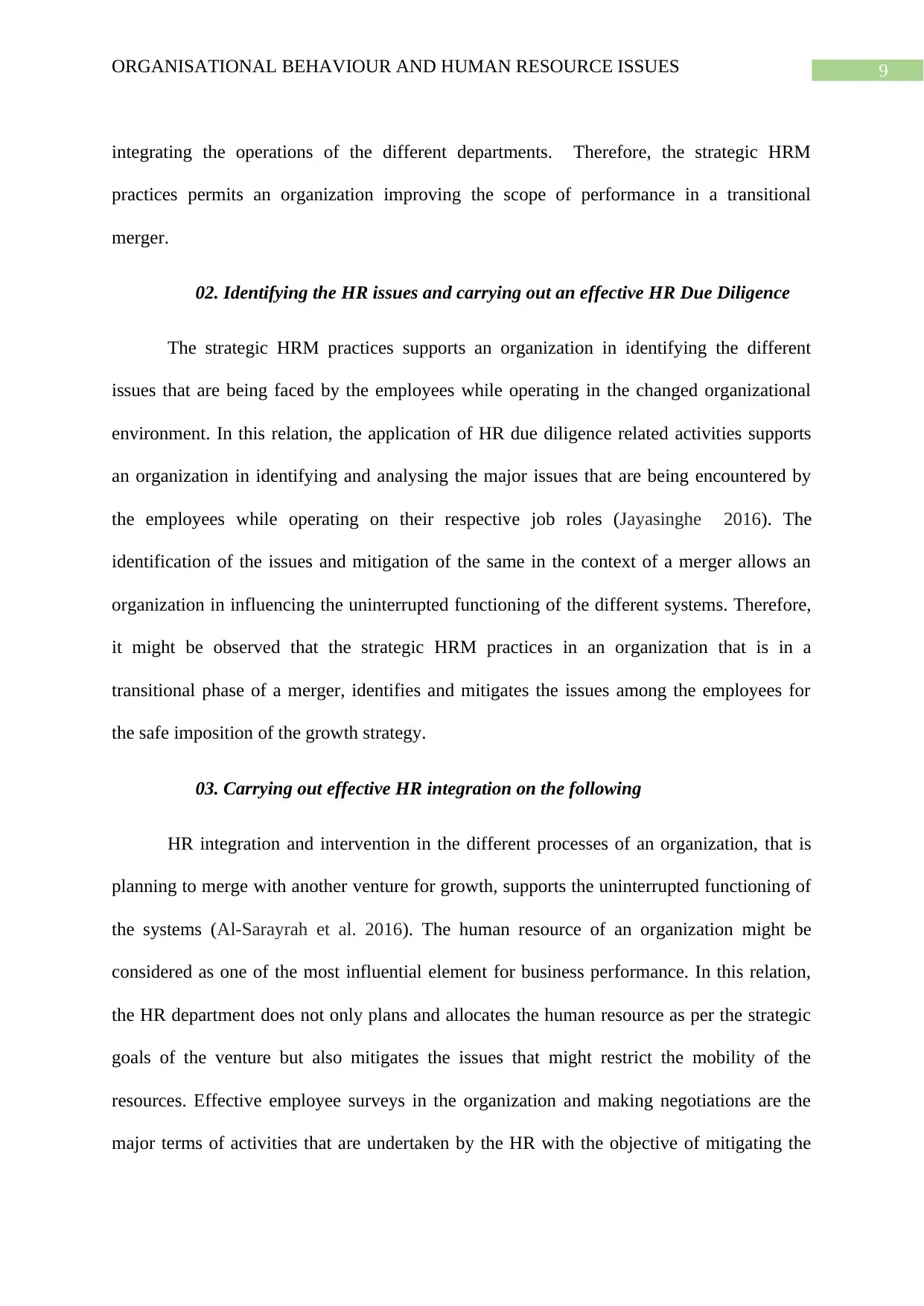
9ORGANISATIONAL BEHAVIOUR AND HUMAN RESOURCE ISSUES
integrating the operations of the different departments. Therefore, the strategic HRM
practices permits an organization improving the scope of performance in a transitional
merger.
02. Identifying the HR issues and carrying out an effective HR Due Diligence
The strategic HRM practices supports an organization in identifying the different
issues that are being faced by the employees while operating in the changed organizational
environment. In this relation, the application of HR due diligence related activities supports
an organization in identifying and analysing the major issues that are being encountered by
the employees while operating on their respective job roles (Jayasinghe 2016). The
identification of the issues and mitigation of the same in the context of a merger allows an
organization in influencing the uninterrupted functioning of the different systems. Therefore,
it might be observed that the strategic HRM practices in an organization that is in a
transitional phase of a merger, identifies and mitigates the issues among the employees for
the safe imposition of the growth strategy.
03. Carrying out effective HR integration on the following
HR integration and intervention in the different processes of an organization, that is
planning to merge with another venture for growth, supports the uninterrupted functioning of
the systems (Al-Sarayrah et al. 2016). The human resource of an organization might be
considered as one of the most influential element for business performance. In this relation,
the HR department does not only plans and allocates the human resource as per the strategic
goals of the venture but also mitigates the issues that might restrict the mobility of the
resources. Effective employee surveys in the organization and making negotiations are the
major terms of activities that are undertaken by the HR with the objective of mitigating the
integrating the operations of the different departments. Therefore, the strategic HRM
practices permits an organization improving the scope of performance in a transitional
merger.
02. Identifying the HR issues and carrying out an effective HR Due Diligence
The strategic HRM practices supports an organization in identifying the different
issues that are being faced by the employees while operating in the changed organizational
environment. In this relation, the application of HR due diligence related activities supports
an organization in identifying and analysing the major issues that are being encountered by
the employees while operating on their respective job roles (Jayasinghe 2016). The
identification of the issues and mitigation of the same in the context of a merger allows an
organization in influencing the uninterrupted functioning of the different systems. Therefore,
it might be observed that the strategic HRM practices in an organization that is in a
transitional phase of a merger, identifies and mitigates the issues among the employees for
the safe imposition of the growth strategy.
03. Carrying out effective HR integration on the following
HR integration and intervention in the different processes of an organization, that is
planning to merge with another venture for growth, supports the uninterrupted functioning of
the systems (Al-Sarayrah et al. 2016). The human resource of an organization might be
considered as one of the most influential element for business performance. In this relation,
the HR department does not only plans and allocates the human resource as per the strategic
goals of the venture but also mitigates the issues that might restrict the mobility of the
resources. Effective employee surveys in the organization and making negotiations are the
major terms of activities that are undertaken by the HR with the objective of mitigating the
Paraphrase This Document
Need a fresh take? Get an instant paraphrase of this document with our AI Paraphraser
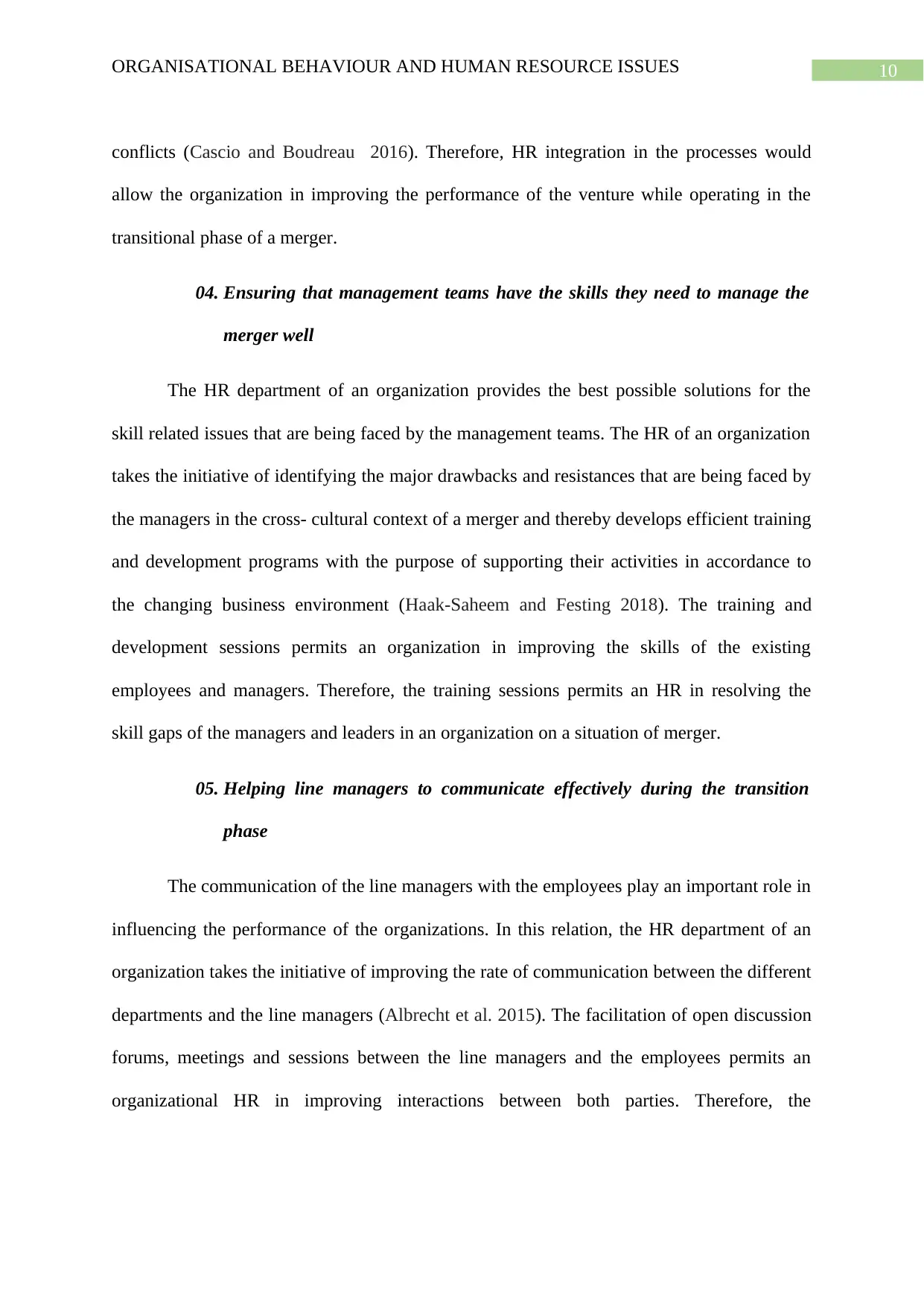
10ORGANISATIONAL BEHAVIOUR AND HUMAN RESOURCE ISSUES
conflicts (Cascio and Boudreau 2016). Therefore, HR integration in the processes would
allow the organization in improving the performance of the venture while operating in the
transitional phase of a merger.
04. Ensuring that management teams have the skills they need to manage the
merger well
The HR department of an organization provides the best possible solutions for the
skill related issues that are being faced by the management teams. The HR of an organization
takes the initiative of identifying the major drawbacks and resistances that are being faced by
the managers in the cross- cultural context of a merger and thereby develops efficient training
and development programs with the purpose of supporting their activities in accordance to
the changing business environment (Haak-Saheem and Festing 2018). The training and
development sessions permits an organization in improving the skills of the existing
employees and managers. Therefore, the training sessions permits an HR in resolving the
skill gaps of the managers and leaders in an organization on a situation of merger.
05. Helping line managers to communicate effectively during the transition
phase
The communication of the line managers with the employees play an important role in
influencing the performance of the organizations. In this relation, the HR department of an
organization takes the initiative of improving the rate of communication between the different
departments and the line managers (Albrecht et al. 2015). The facilitation of open discussion
forums, meetings and sessions between the line managers and the employees permits an
organizational HR in improving interactions between both parties. Therefore, the
conflicts (Cascio and Boudreau 2016). Therefore, HR integration in the processes would
allow the organization in improving the performance of the venture while operating in the
transitional phase of a merger.
04. Ensuring that management teams have the skills they need to manage the
merger well
The HR department of an organization provides the best possible solutions for the
skill related issues that are being faced by the management teams. The HR of an organization
takes the initiative of identifying the major drawbacks and resistances that are being faced by
the managers in the cross- cultural context of a merger and thereby develops efficient training
and development programs with the purpose of supporting their activities in accordance to
the changing business environment (Haak-Saheem and Festing 2018). The training and
development sessions permits an organization in improving the skills of the existing
employees and managers. Therefore, the training sessions permits an HR in resolving the
skill gaps of the managers and leaders in an organization on a situation of merger.
05. Helping line managers to communicate effectively during the transition
phase
The communication of the line managers with the employees play an important role in
influencing the performance of the organizations. In this relation, the HR department of an
organization takes the initiative of improving the rate of communication between the different
departments and the line managers (Albrecht et al. 2015). The facilitation of open discussion
forums, meetings and sessions between the line managers and the employees permits an
organizational HR in improving interactions between both parties. Therefore, the
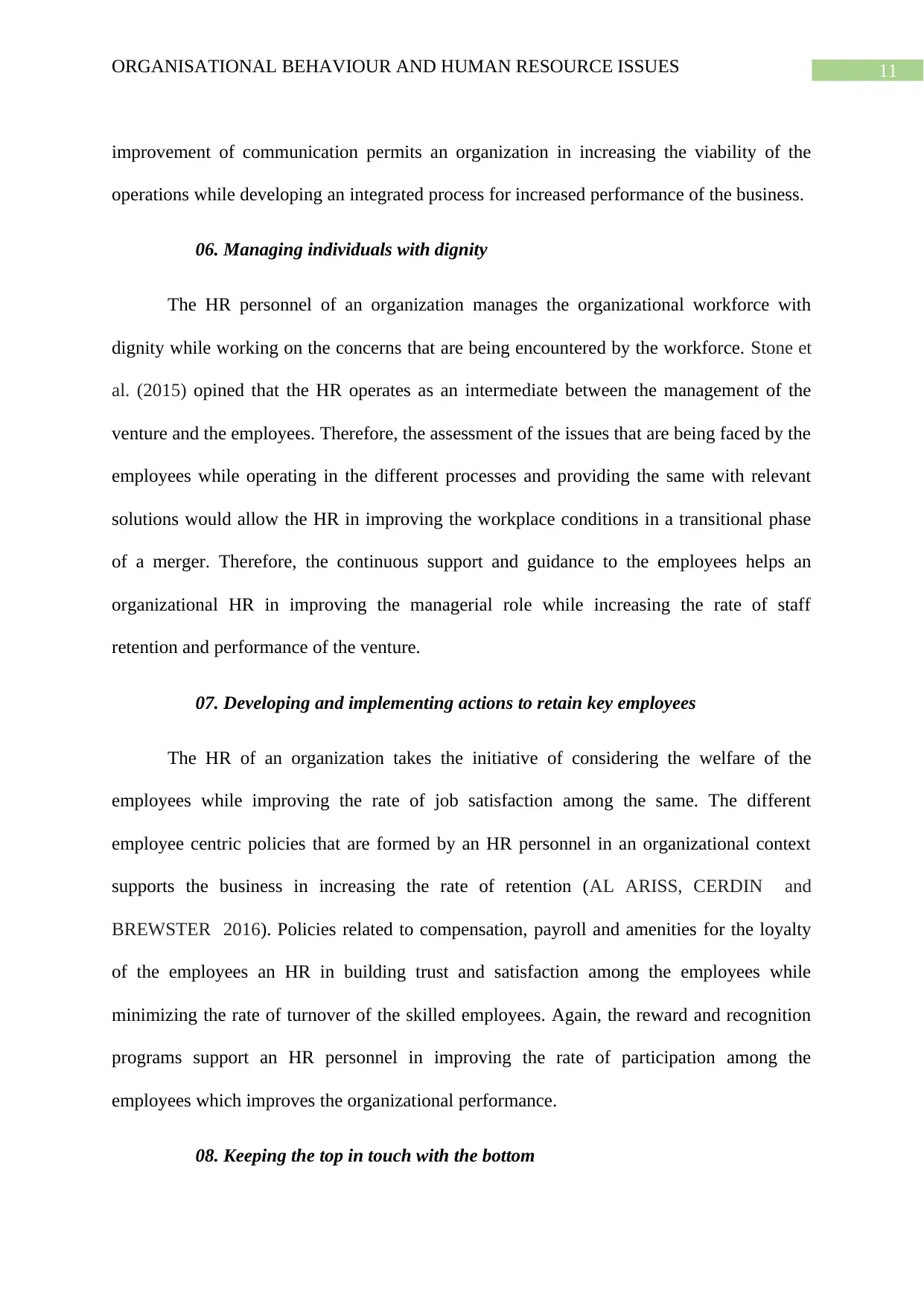
11ORGANISATIONAL BEHAVIOUR AND HUMAN RESOURCE ISSUES
improvement of communication permits an organization in increasing the viability of the
operations while developing an integrated process for increased performance of the business.
06. Managing individuals with dignity
The HR personnel of an organization manages the organizational workforce with
dignity while working on the concerns that are being encountered by the workforce. Stone et
al. (2015) opined that the HR operates as an intermediate between the management of the
venture and the employees. Therefore, the assessment of the issues that are being faced by the
employees while operating in the different processes and providing the same with relevant
solutions would allow the HR in improving the workplace conditions in a transitional phase
of a merger. Therefore, the continuous support and guidance to the employees helps an
organizational HR in improving the managerial role while increasing the rate of staff
retention and performance of the venture.
07. Developing and implementing actions to retain key employees
The HR of an organization takes the initiative of considering the welfare of the
employees while improving the rate of job satisfaction among the same. The different
employee centric policies that are formed by an HR personnel in an organizational context
supports the business in increasing the rate of retention (AL ARISS, CERDIN and
BREWSTER 2016). Policies related to compensation, payroll and amenities for the loyalty
of the employees an HR in building trust and satisfaction among the employees while
minimizing the rate of turnover of the skilled employees. Again, the reward and recognition
programs support an HR personnel in improving the rate of participation among the
employees which improves the organizational performance.
08. Keeping the top in touch with the bottom
improvement of communication permits an organization in increasing the viability of the
operations while developing an integrated process for increased performance of the business.
06. Managing individuals with dignity
The HR personnel of an organization manages the organizational workforce with
dignity while working on the concerns that are being encountered by the workforce. Stone et
al. (2015) opined that the HR operates as an intermediate between the management of the
venture and the employees. Therefore, the assessment of the issues that are being faced by the
employees while operating in the different processes and providing the same with relevant
solutions would allow the HR in improving the workplace conditions in a transitional phase
of a merger. Therefore, the continuous support and guidance to the employees helps an
organizational HR in improving the managerial role while increasing the rate of staff
retention and performance of the venture.
07. Developing and implementing actions to retain key employees
The HR of an organization takes the initiative of considering the welfare of the
employees while improving the rate of job satisfaction among the same. The different
employee centric policies that are formed by an HR personnel in an organizational context
supports the business in increasing the rate of retention (AL ARISS, CERDIN and
BREWSTER 2016). Policies related to compensation, payroll and amenities for the loyalty
of the employees an HR in building trust and satisfaction among the employees while
minimizing the rate of turnover of the skilled employees. Again, the reward and recognition
programs support an HR personnel in improving the rate of participation among the
employees which improves the organizational performance.
08. Keeping the top in touch with the bottom
⊘ This is a preview!⊘
Do you want full access?
Subscribe today to unlock all pages.

Trusted by 1+ million students worldwide
1 out of 26
Related Documents
Your All-in-One AI-Powered Toolkit for Academic Success.
+13062052269
info@desklib.com
Available 24*7 on WhatsApp / Email
![[object Object]](/_next/static/media/star-bottom.7253800d.svg)
Unlock your academic potential
Copyright © 2020–2025 A2Z Services. All Rights Reserved. Developed and managed by ZUCOL.





